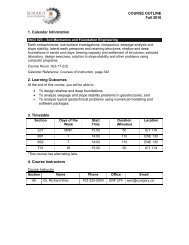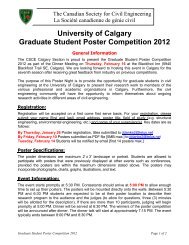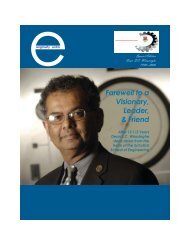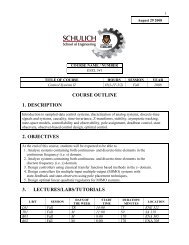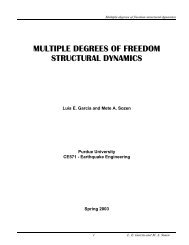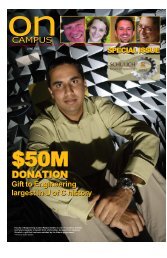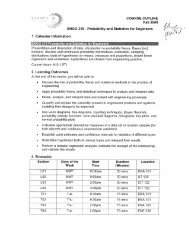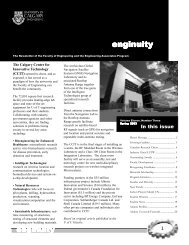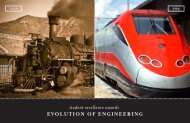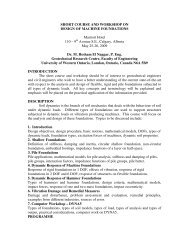high performance - The Schulich School of Engineering - University ...
high performance - The Schulich School of Engineering - University ...
high performance - The Schulich School of Engineering - University ...
- No tags were found...
You also want an ePaper? Increase the reach of your titles
YUMPU automatically turns print PDFs into web optimized ePapers that Google loves.
Photo by David MollMAY THE ATHLETEWITH THE BESTEQUIPMENT WINBY DON MCSWINEYVICTORY OFTEN COMES DOWNTO THE SMALLEST DETAILS.NEW TECHNOLOGIES BECOMEINCREASINGLY IMPORTANT,AND CANADIAN ATHLETES ANDCOACHES ARE LOOKING TOSCIENCE TO HELP THEM CROSSTHAT FINISH LINE A BLINKBEFORE THE COMPETITION.When the rest <strong>of</strong> Canada began theVancouver 2010 countdown fouryears ago, engineers were already engagedin finding ways to help Canadian athletestrain more efficiently, more safely and insome cases, in finding ways <strong>of</strong> improving<strong>performance</strong>. It was a process that beganshortly after the disappointing 2002 SaltLake City Olympics.“Everyone knew that the equipment wewere competing with in 2002 in Salt LakeCity was inferior. Skates, skis, suits … ourequipment was simply not up to the levelbeing used by the rest <strong>of</strong> the world,” saysRoger Jackson, head <strong>of</strong> Canada’s ambitiousOwn the Podium project. Jackson isa former Olympian, former dean <strong>of</strong>kinesiology at the <strong>University</strong> <strong>of</strong> Calgaryand lynchpin <strong>of</strong> the 1988 Calgary Olympics.Own the Podium has a simple mandate– to help Canadian athletes consistentlycompete with the world’s best. This entailsmany different strategies, but one <strong>of</strong> themost important is to make sure Canadauses cutting-edge science to stay currentwith the rest <strong>of</strong> the world and in thecase <strong>of</strong> a <strong>Schulich</strong> <strong>School</strong> <strong>of</strong> <strong>Engineering</strong>geomatics engineering project for AlpineCanada Alpin (ACA), to get way in front <strong>of</strong>the rest <strong>of</strong> the world.Alpine skiing is an intensely technicalsport that marries the best technologywith elite athletic <strong>performance</strong>. It’s alsoone <strong>of</strong> those sports where first place andlast place can come down to hundredths<strong>of</strong> a second. Athletes reach speeds over150 km an hour and need to keep to anearly perfect ‘line’ to have any chance <strong>of</strong>finishing on the podium.“<strong>The</strong> perfect line,” explains biomechanicsresearcher Gerald Cole, “is the line thatallows a skier to come out <strong>of</strong> a turn in perfectposition to make the next turn.” GeraldCole, who works with the <strong>Schulich</strong> <strong>School</strong> <strong>of</strong><strong>Engineering</strong> and the Faculty <strong>of</strong> Kinesiologyat the <strong>University</strong> <strong>of</strong> Calgary, was brought inby ACA as a consultant to help them excelin areas <strong>of</strong> biomechanics and engineering.When ACA coaching staff brought upthe need for a viable GPS training device,Cole knew just where to turn – Pr<strong>of</strong>essorGérard Lachapelle, Canada Research Chair/Informatics Circle <strong>of</strong> Research Excellence(iCORE) Chair in Wireless Location, andhis world-leading research group at the<strong>Schulich</strong> <strong>School</strong> <strong>of</strong> <strong>Engineering</strong>. Under ajoint sponsorship <strong>of</strong> the <strong>Schulich</strong> <strong>School</strong>,iCORE, Own the Podium and Calgary-basedNovAtel Inc. – which provided some <strong>of</strong> the<strong>high</strong> <strong>performance</strong> hardware – his team wenton to solve the problem in fall 2006. >>SCHULICH10 ENGINEERSCHULICH 11 ENGINEER



